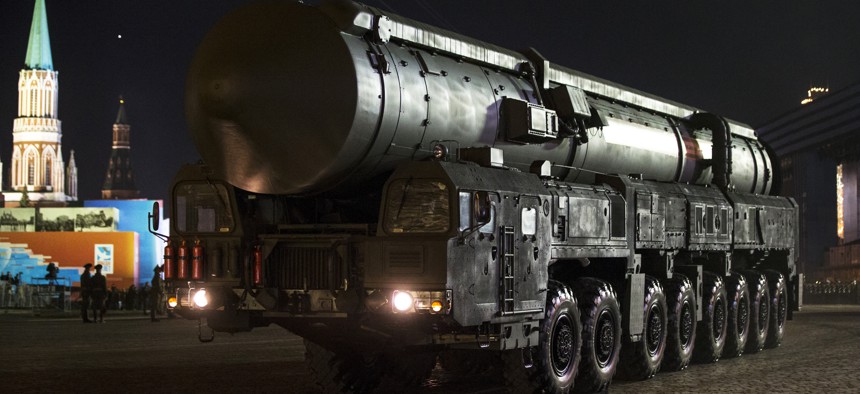
ussian army The RS-24 Yars ballistic missile make their way through the Red Square during a rehearsal for the Victory Day military parade which will take place at Moscow's Red Square, May 9, 2015. AP / PAVEL GOLOVKIN
The Russians Just Test-Fired an ICBM
Both Washington and Moscow are modernizing their nuclear arsenals, but military leaders worry that Russia is ahead.
The Russian military on Wednesday test-fired an RS-24 Yars, one of their newest intercontinental ballistic missiles, Russian state media sources reported.
The solid-fueled ICBM, “equipped with a detachable warhead, arrived at the designated area on the Kura test range on the Kamchatka Peninsula at the state-owned Plesetsk Test Space Cosmodrome with the Yoshkar-Ola missile connection,” Russia’s Ministry of Defense announced via TASS.
Russia and the United States are both working to modernize their ICBMs, each to the chagrin of the other.
In 2010, the countries signed the New START Treaty, ostensibly limiting the number of nuclear weapons each could build and deploy. But Russia has continued to increase its stock of warheads, even as it hews to the treaty limit of 700 launchers, says Hans M. Kristensen, who runs the Nuclear Information Project at the Federation of American Scientists
Launch of an RS-24 Yars Intercontinental Ballistic Missile in Plesetsk, #Russia today. pic.twitter.com/4Xq1B6TmGh
— Mikhail D. (@Eire_QC) September 20, 2017
“The aggregate data shows that Russia has continued to increase its deployed strategic warheads since 2013 when it reached its lowest level of 1,400 warheads. Russian strategic launchers now carry 396 warheads more,” Kristensen wrote in October. “Overall, Russia has increased its deployed strategic warheads by 259 warheads since New START entered into force in 2011. Although it looks bad, it has no negative implications for strategic stability.”
Still, even the designation of the missile is in dispute, as Russia calls it a brand-new missile while the U.S. insists that it is a variant of the Topol M, forbidden under arms-control treaties.
Russian efforts to improve their ICBMs are spooking many in Washington, where the purchase of a new ICBM is being contemplated. The Air Force has already awarded Boeing and Northrop Grumman contracts for preliminary technology, although Defense Secretary Jim Mattis says no final decision has been made to replace today’s Minuteman III missiles.
U.S. military leaders worry that Moscow is leaping ahead. “The Russians are modernizing their entire nuclear force and their entire nuclear force will be modernized before we start modernizing our force,” Lt. Gen. Jack Weinstein, the Air Force’s deputy chief of staff for strategic deterrence and nuclear integration, said at the Air Force Association’s annual conference on Tuesday.
The U.S. modernization effort has met with controversy among national security elites. Former Defense Secretary William Perry has cautioned repeatedly and strongly against maintaining an ICBM stockpile and has argued that U.S. ICBMs should be scrapped, turning the decades-old nuclear triad into a diad of bombers armed with cruise missiles and submarines with long-range missiles.
But others within the U.S. nuclear establishment disagree. On Tuesday, Weinstein, for example, stressed what he called the necessity of new ICBMs.
“During the Cold War, there was never a question … on the need to have a deterrent force to protect this nation. Why was there a belief on the importance of a deterrent force? The belief was that this conflict, this Cold War, was going to last forever so of course you needed to modernize these systems.”
But today, said Weinstein, some believe that the U.S. and Russia can return to more friendly relations despite recent aggressive actions by Vladimir Putin, such as illegally annexing territory that does not belong to Russia and deploying a missile that is barred by the INF treaty. This notion is mistaken, he said.
“My belief is that the behavior of Vladimir Putin and the Russian Federation Today is the normal behavior of the Russian Federation and that’s why the need of a deterrent force transcends this time element,” he said.
Wednesday’s test-launch of the RS-24 Yars comes as the Russian military wrap up a massive, multifaceted wargame dubbed Zapad-17. A portion of the exercise looks at civil defense response to a nuclear strike on Russia.




